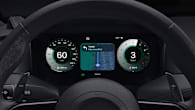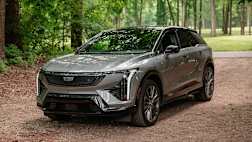Electric cars come in all shapes and sizes these days, but arguably the most logical shape is the hatchback. Why? Well, as much as Australians love SUVs and bigger luxury cars, the humble hatch makes the most efficient use of space. And if you’re going to buy an electric car, it makes sense to be concerned about efficiency.
Thankfully, in contrast with an overall decline in the small-car market, there is an increasingly diverse range of battery-powered hatchbacks to choose from. The list of hatchback electric cars is getting longer each month with new brands jumping into the fray.
And while space and size are key attractions of the electric hatch, there is another element that makes them popular - price. At the time of publication the most affordable electric car you can buy is an EV hatchback, opening up the nascent market for more people.
-
Yet another Tesla Model Y and Kia EV5 rival? BYD Seal X electric car details revealed as production version of Ocean-M concept packs up to 310kW - report
-
BYD's building a hot hatch? BYD Ocean M hot hatch concept previews a new hatchback electric car coming to take on MG4 - report
-
MG Australia slashes drive-away prices of its cheapest models and popular SUVs by thousands, including 2024 MG ZST, HS plug-in hybrid SUV and MG 3 hatchback
One excellent example is the much-praised MG4, which has emerged not only as one of the better selling EVs in the country but is on track to be one of the most popular small cars over all. In 2023, it out sold the likes of the Subaru Impreza and Honda Civic and is trending upwards in 2024.
Yet another reason why electric hatches are gaining popularity in Australia is availability, with those willing to look beyond an SUV discovering a good supply of electric hatchbacks in Australia.
This is because of the volume of choice and diversity of models, with at least eight examples already in showrooms and more planned to follow in the near future.
The biggest questions are what is the future of electric hatchbacks expected to look like in Australia?
The answer to the question is more choice for smaller, more affordable EVs, but there is also likely to be more crossover between a true hatchback and a modern crossover. Models like the Renault Megane E-Tech and Volvo EX30 blur the lines between a hatch and an SUV but that appears to be a future trend.
One key element missing from the market is a Tesla hatchback, and that would be a potential game changer. The American brand has repeatedly hinted at adding a hatch, likely to be known as the Model 2, as a cheaper offering to sit beneath the Model 3 sedan.
In the shorter-term there are several new EV hatches likely to be hitting Australian roads in the not-too-distant future, including the Volkswagen ID.3, Peugeot e-208 and Renault 5 E-Tech.
Not that we need to gaze longingly into a crystal ball to look for the next small EV. Below is a list of the best electric hatchbacks on the Australian market at the time of publication.
Top 7 most popular electric hatchbacks in Australia
GWM Ora - from $35,990*
Ranking the list of available electric hatchbacks by price is no easy task thanks to the highly competitive nature of the market at this moment in time.
MG announced its small car would be the cheapest EV at $39,990, only for BYD to undercut it within days, and then GWM joined the party. It only gets more confusing thanks to a series of drive-away deals, such as the one GWM is currently (at time of publication) offering on its (not-at-all-a-Mini-why-do-you-ask) Ora small car.
.jpg)
Its original asking price of $39,990 drive-away has been slashed to $35,990, making it the cheapest EV you can buy. For the money, you get up to 310km of driving range on a single charge and 126kW of performance.
BYD Dolphin - from $38,890
If you’re looking to Build Your Dreams of an electric car on a budget, then the Dolphin is for you. It arrived with a bang, sporting the lowest sticker price of any EV in Australia by starting at $38,890, which undercut the Ora and MG4 by $100 - at least on paper, at the time. However, the Chinese brand is offering a drive-away price of $41,490, which makes it more expensive than the GWM and MG in this current price war.
.jpg)
For that money you get a Dolphin Dynamic, a small car with space for five, a 70kW/180Nm electric motor and a battery good for 340km of driving range. There’s a Dolphin Premium, with a 150kW/310Nm motor and 427km of range (plus bigger wheels, two-tone paint and other extras) but that’s an additional $6000.
MG4 - from $43,131*
The price of the MG4 is another moving target in the battle for affordability being fought out amongst the three Chinese carmakers. It has floated up and down, reaching as low as $39,990 drive-away for the run-out sale of 2023 examples, but was sitting at $43,131 drive-away for the 2024 model at the time of publication.

It’s a spacious and practical small car, with 350km range from its 51kWh battery and a 125kW motor for the entry-level Excite 51 model that has the sharpest price.
There are three more variants in the range, the 64kWh and 77kWh standard models and the MG4 XPower electric hot hatch. The latter boasts impressive performance credentials, with 320kW/600Nm and 400km of range for $63,973 drive-away.
Nissan Leaf - from $50,990
The fully electric hatchback that arguably started it all, the Leaf was the first mainstream small EV hatchback that was broadly accepted in the local market (with apologies to the Mitsubishi i-MiEV) way back in 2012, when the Tesla Cybertruck wasn’t even a glint in Elon Musk’s mad eyes.
Even though a second-generation model was introduced in 2018 (which was largely a makeover) the Leaf is starting to show its age in terms of both design and technology.

The standard model is equipped with a 39kWh battery that’s only enough for 270km of range and it powers a 110kW motor. There’s a more powerful Leaf+ available, which gains a 58kWh battery to boost range to 385km.
Its official list price is $50,990, but in a bid to keep up with its newer competition, Nissan Australia is offering it for $39,990 drive-away for the standard model and $49,990 drive-away for the Leaf+.
Fiat 500e - from $52,500
If you’re looking for a truly compact electric car then look no further than this pint-sized city runabout. Fiat has managed to keep the tiny dimensions of the petrol-powered 500 and package up an all-electric powertrain inside a stylish small car.
It’s not a cheap proposition at $52,500 plus on-road costs, which makes it a premium EV by many standards, but it is well-equipped for the price and does give you a more upmarket feel than most of the cars on this list.

It doesn’t have a particularly powerful motor, just 87kW/220Nm, but it certainly feels zippy on the road. Being so small it can’t fit lots of batteries, so the range is limited to just 311km, which does limit it to being more of an urban EV rather than something for long-distance drives.
If you like the Fiat but want something sportier, you can consider the Abarth 500e. The Italian brand’s performance division has wound up the power to 113.7kW/235Nm and added a sound generator for a more exciting driving experience.
It carries a price premium, too, starting at $58,990 (plus on-road costs) for the Turismo and $60,500 for the Scorpionissima variant.
Mini Electric - from $59,830*
The British brand may not be thought of in the same sentence as Tesla and Polestar, but it is surprisingly ahead of the curve when it comes to EVs. It has just launched its second-generation electric Cooper hatch with an electric Countryman and Aceman to follow soon.

It’s arrived with a sharp $59,830 drive-away price for the Cooper E and $65,040 for the more potent Cooper SE, no doubt helped by the brand’s decision to share development and production with GWM.
The Cooper E boasts 135kW and a 305km range, with the Cooper SE boosting those numbers to 160kW and 402km.
Cupra Born - from $59,990
While Volkswagen awaits its first EVs, its Spanish off-shoot is already leading the way with its electric hot hatch. While it’s significantly more expensive than the first cars on this list, it comes with more features, equipment, performance and range to help justify the extra ask.

Key amongst its performance credentials is the fact it’s rear-wheel drive, something few other hatches can claim. It’s powered by a 170kW/310Nm motor to provide hot-hatch levels of speed and has a 82kWh battery that provides an impressive 511km of claimed driving range.







.jpg)

.jpg)
.jpg)


.jpg)






.jpg)